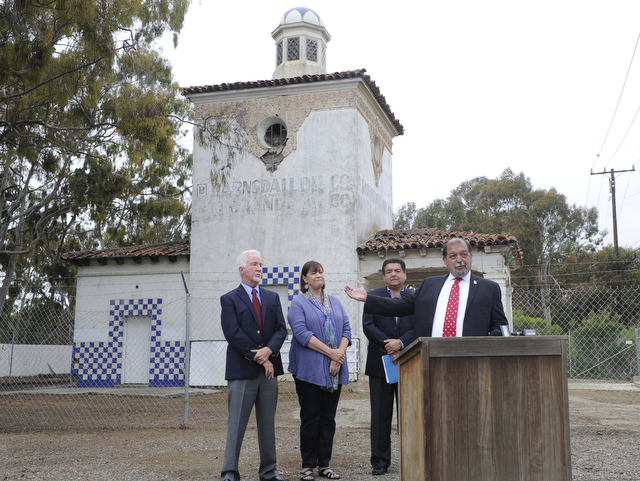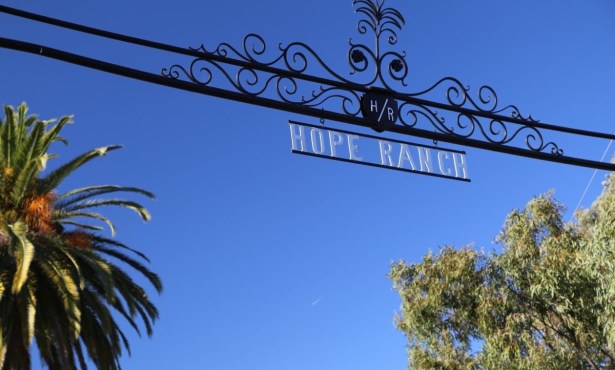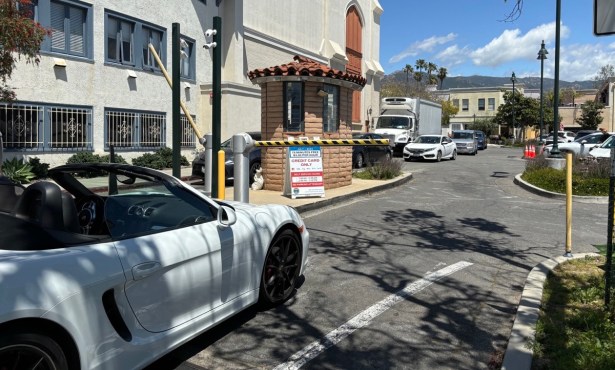Gift of Historic Gas Station Building Held Up by Bankruptcy
Tangled Property Details Delay Barnsdall-Rio Grande Donation

It’s been a more than year since the Goleta City Council meeting that considered the gift from Ty Warner of the antique Barnsdall-Rio Grande gas station that sits on the western point of Hollister Avenue, a meeting that may have shaken the council’s confidence in a key city official. The contract that had been drawn up to gift the property contained a poison pill that was not mentioned in the staff report, several councilmembers observed uneasily. In essence, the underlying property ownership document contains a covenant that is inherited by the next owner; it prevents the gas station owner from taking any actions against the Ellwood Onshore Facility.
The gas station in question at one time greeted all travelers arriving after a rough ride from Lompoc, according to Sentinel in Ellwood, a 1985 monograph by Gary Coombs and Phyllis Olsen that recounts the history of the building and the companies that built it. The station marked the entrance to the Ellwood oil fields — a joint project of Barnsdall Oil Company and Rio Grande Oil Company. The two had found oil, after some skirmishing between its engineers, at an estate once called Ellwood Terrace, and now called Sandpiper Golf Club, owned by Kate Den Bell, the eldest daughter of Nicholas Den whose rancho stretched from Fairview Avenue nearly to El Capitan.
Kate Den Bell had proclaimed at a 1920 family gathering that oil, which had been unsuccessfully searched for in nearby Las Armas Canyon and Coal Oil Point, was probably beneath her feet. But no one would be allowed to find out until after she was dead, she added, because the inheritance taxes would otherwise be astronomical. She was, of course, correct. The year after her death in 1927, a highly pressurized crude with little water or sulfur spurted out of a drill hole sunk not far from where she’d stood, Coombs and Olsen wrote.

The gas station’s lavishly tiled two-story tower and lighted cupola were a response to Pearl Chase’s challenge — issued via the Community Plans and Planting branch of the Community Arts Association she led — to build the most handsome gas station in the area; they generally resembled utilitarian boxes. The Barnsdall station won first prize, with a merit-worthy element judged to be that it was “relatively free from signs.”
Completed in 1929, the station pumped gas for nearly 30 years — its fate was sealed when Highway 101 was completed in 1947 and bypassed Hollister Avenue — changing ownership along the way from Barnsdall and Rio Grande to Sinclair Consolidated Oil Company in a merger, and later to Richfield Oil Company in another merger; Richfield morphed into Atlantic Richfield, or ARCO, which owned the land under and around the station until 1972, when Ken Hunter bought it for the golf course. An entity called Aradon, described as a Venoco project, in 1990 came to own the Ellwood Onshore Facility next door, which the City of Goleta wants to see closed. Venoco’s 2017 bankruptcy complicates matters.
Ty Warner Hotels and Resorts bought Sandpiper Golf Club in 2003, and in 2015, its representative, Bill Medel, offered to donate the landmark building to Goleta. Warner is still enthusiastic about giving the city the building, Medel said, calling it an amazing historic structure that had to be preserved, not torn down.
Correspondence from city spokesperson Valerie Kushnerov last week indicates a disagreement with former city attorney Tim Giles’s reassurances that the city’s options when it came to the EOF would be intact under the contract he’d negotiated with Sandpiper; Giles resigned within a month of making those statements. Kushnerov stated the city’s current position was that: “The Transfer Agreement whereby the City would accept the donation of the Barnsdall-Rio Grande gas station building included a provision that would have severely restricted the City’s ability to take actions in opposition to Venoco’s right to operate the EOF.”
At the December 20, 2016, City Council meeting, Giles presented a revised agreement developed mainly under the previous council, which had left office on the 6th. With Sandpiper’s attorneys, he’d added a sentence the previous week, which he read to the council: “Nothing in this agreement can be deemed or interpreted to mean that transferee must or cannot exercise its police powers in accordance with applicable law.” He believed that sentence sufficiently preserved the city’s interests. By contrast, the full-page Covenant states that the successor owner agrees to not oppose or support anyone opposing Venoco’s right to operate the EOF. That included lobbying or writing letters, Giles acknowledged under questioning from Councilmember Kyle Richards.
Widely viewed by residents as a hazard that could leak oil into the ocean or emit potentially deadly hydrogen sulfide and other oil refinery toxins like benzene and toluene, the EOF’s continued existence has come into doubt under the city’s current council, which is more interested in closing the facility than previous councils. Though all councilmembers thanked Warner for the generosity of his intended gift, only Councilmember Roger Aceves spoke strongly in favor of the Transfer Agreement as it was written.
Venoco’s ongoing Chapter 11, triggered by the shutdown of the pipeline that caused the 2015 Refugio Oil Spill, will likely result in the sale of its assets, including the EOF, should a buyer be found for the site. The lands have been the site of oil processing since Platform Holly was completed in 1967. Kushnerov indicated the city would not be able to consider the donation until the bankruptcy concluded and the covenant’s effect was determined in light of the new owner.



